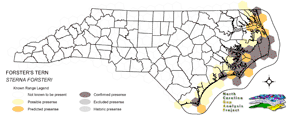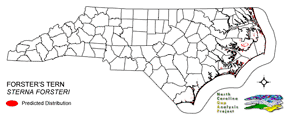
| Taxa: |
| Order: |
| Family: |
| Aves |
| Charadriiformes |
| Laridae |
| NatureServe Global Rank: |
| NatureServe State (NC) Rank: |
| G5 |
| S3B,S5N |
| Federal Status: |
| NC State Status: |
| --- |
| W2 |


| Land Unit |
| US Fish & Wildlife Service |
| US Forest Service |
| US National Park Service |
| US Department of Defense |
| NC State Parks |
| NC University System |
| NC Wildlife Res. Com. |
| NC Forest Service |
| NC Div. of Coastal Mgmt. |
| Local Governments |
| Non-Governmental Org. |
| Other Public Lands |
| Private Lands |
| GAP Status 1-2 |
| All Protected Lands |
| Statewide |
| Hectares |
| 17,741.52 |
| 387.45 |
| 8,375.31 |
| 9,836.01 |
| 1,796.40 |
| 14.22 |
| 4,189.68 |
| 0.00 |
| 1,644.57 |
| 2.70 |
| 2,059.20 |
| 35.19 |
| 70,443.63 |
| 31,650.12 |
| 45,541.26 |
| 116,525.88 |
| Acres |
| 43,840.24 |
| 957.41 |
| 20,695.84 |
| 24,305.31 |
| 4,439.00 |
| 35.14 |
| 10,352.92 |
| 0.00 |
| 4,063.82 |
| 6.67 |
| 5,088.39 |
| 86.96 |
| 174,069.97 |
| 78,209.13 |
| 112,534.88 |
| 287,941.66 |
| % of Dist. on |
| Prot. Lands |
| 39.0 % |
| 0.9 % |
| 17.2 % |
| 21.6 % |
| 3.9 % |
| < 0.1 % |
| 9.2 % |
| 0.0 % |
| 3.6 % |
| 4.5 % |
| 4.5 % |
| < 0.1 % |
| < 0.1 % |
| 69.5 % |
| ----- |
| ----- |
| % of Dist. on |
| All Lands |
| 15.2 % |
| 0.3 % |
| 7.2 % |
| 8.4 % |
| 1.5 % |
| < 0.1 % |
| 3.6 % |
| 0.0 % |
| 1.4 % |
| < 0.1 % |
| 1.8 % |
| < 0.1 % |
| 60.5 % |
| 27.2 % |
| ----- |
| ----- |
|
Fairly common on the barrier islands and some adjacent marshy mainland sites, except uncommon south of Beaufort Inlet (Fussell 1994). Loose colonies nest in salt marshes and estuaries (Fussell 1994, Kaufman 1996). In other parts of the species' range, also found near fresh water marshes and lakes (Kaufman 1996). Forages on insects taken in flight over marsh or on fish taken by diving (Ehrlich et al. 1988) and skimming the water's surface (Kaufman 1996). Nest is built on top of marsh vegetation, floating debris, or occasionally a muskrat den (Ehrlich et al. 1988) or the nest of a grebe (Kaufman 1996). Human-made nesting platforms made of bundles of PHRAGMITES or TYPHA on floating base of styrofoam and wood or tires were readily used for nesting in Wisconsin (see Spendelow and Patton 1988). NATURE SERVE GLOBAL HABITAT COMMENTS: Freshwater and salt marshes, in migration and winter also seacoasts, bays, estuaries, rivers and lakes (AOU 1983). Nests on inland lakes and marshes, or on salt marshes (especially on wrack) along the coast. Along the Gulf Coast, commonly nests on dredged material as well as on wrack in salt marshes. At San Francisco Bay, California, commonly nests on old dikes or dredged-material islets in salt evaporation ponds. Nests on floating mass of marsh plants, on muskrat house, or old grebe's nest, or in a depression lined with grasses and pieces of shells. Human-made nesting platforms made of bundles of PHRAGMITES or TYPHA on floating base of styrofoam and wood or tires were readily used for nesting in Wisconsin (see Spendelow and Patton 1988). See Spendelow and Patton (1988) for further information on freshwater nesting habitats. See Cuthbert and Louis (1993) for information on nesting habitat in Minnesota. |
| Code | Name | Description | NC Natural Heritage Program Equivalent |
| 378 | Ocean Beaches | Open beach sand. | Upper Beach |
| 3 | Tidal Marsh | Fresh and brackish tidal marshes, including cord grass, wild rice, sawgrass and needlerush alliances. | Brackish Marsh, Interdune pond, Maritime wet grassland |
| 375 | Hypersaline coastal salt flats | Tidal flats within salt marshes, including saltmeadow cordgrass or sea-purslane dominated alliances. | Salt Marsh |
| 372 | Interdune Herbaceous Wetlands | Dune swales with permanently flooded to intermittently exposed hydrology. Species composition depends on salinity and can include cut grass, spike-rush, mosquito fern, and hornwort. | Interdune Pond, Maritime Wet Grasslands |
| 371 | Maritime Grasslands | Dune grass community consisting of sea oats and beach grasses. | Dune grass, Maritime dry grassland |
| 380 | Coastal Plain Fresh Water Emergent | Emergent vegetation in fresh water seepage bogs, ponds and riverbeds of the coastal plain. Includes alliances dominated by sedges, eelgrass, as well as cane found in unforested cane-brakes. | Small Depression Pond, Sandhill Seep, Floodplain Pool, Unforested Floodplain Canebrake, Riverscour Prairies, Vernal Pools |
| 173 | Coastal Plain Riverbank Shrubs | Shrub dominated riverbanks, commonly dominated by willows and/or alders. | Sand and Mud Bar |
| 8 | Open water | Open water without aquatic vegetation. | No equivalent |
|
Cuthbert, F. J., and M.-Y. Louis. 1993. The Forster's tern in Minnesota:status, distribution, and reproductive success. Wilson Bull. 105:184-187.
Herkert, J. R., editor. 1992. Endangered and threatened species of Illinois:status and distribution. Vol. 2:Animals. Illinois Endangered Species Protection Board. iv + 142 pp. Fussell, J.O. III. 1994. A birderís guide to coastal North Carolina. Chapel Hill and London: The University of North Carolina Press. Kaufman K. 1996. Lives of North American Birds. Boston, New York: Houghton Mifflin Company. Oberholser, H.C. 1974. The bird life of Texas. 2 vols. Univ. of Texas Press, Austin. Clapp, R. B., and P. A. Buckley. 1984. Status and conservation of seabirds in the southeastern United States. Pages 135-155 in Croxall et al., eds. Status and conservation of the world's seabirds. ICBP Tech. Pub. No. 2. Harrison, C. 1978. A field guide to the nests, eggs and nestlings of North American birds. Collins, Cleveland, Ohio. Terres, J.K. 1980. The Audubon Society encyclopedia of North American birds. Alfred A. Knopf, New York. American Ornithologists' Union (AOU), Committee on Classification and Nomenclature. 1983. Check-list of North American Birds. Sixth Edition. American Ornithologists' Union, Allen Press, Inc., Lawrence, Kansas. Ehrlich, P.R., D.S. Dobkin, and D. Wheye. 1988. The birder's handbook:a field guide to the natural history of North American birds. Simon and Shuster, Inc., New York. xxx + 785 pp. Spendelow, J.A., and S.R. Patton. 1988. National atlas of coastal waterbird colonies in the contiguous United States:1976-1982. U.S. Fish and Wildlife Service, Biological Report 88(5). x + 326 pp. Byrd, M.A., and D.W. Johnston. 1991. Birds. Pages 477-537 in K. Terwilliger, coordinator. Virginia's endangered species:proceedings of a symposium. McDonald and Woodward Publ. Co., Blacksburg, Virginia. Stiles, F.G., and A.F. Skutch. 1989. A guide to the birds of Costa Rica. Comstock Publ. Associates, Cornell University Press, Ithaca, New York. 511 pp. |
For more information please contact them at:
NC-GAP Analysis Project
Dept. of Zoology, NCSU
Campus Box 7617
Raleigh, NC 27695-7617
(919) 513-2853
www.basic.ncsu.edu/ncgap